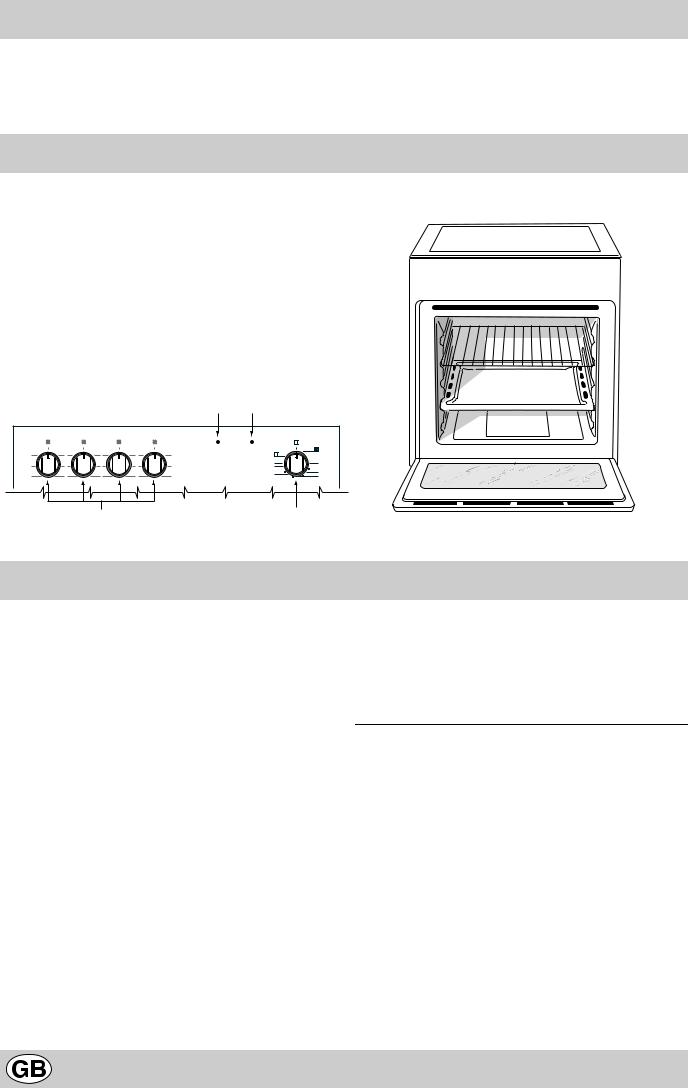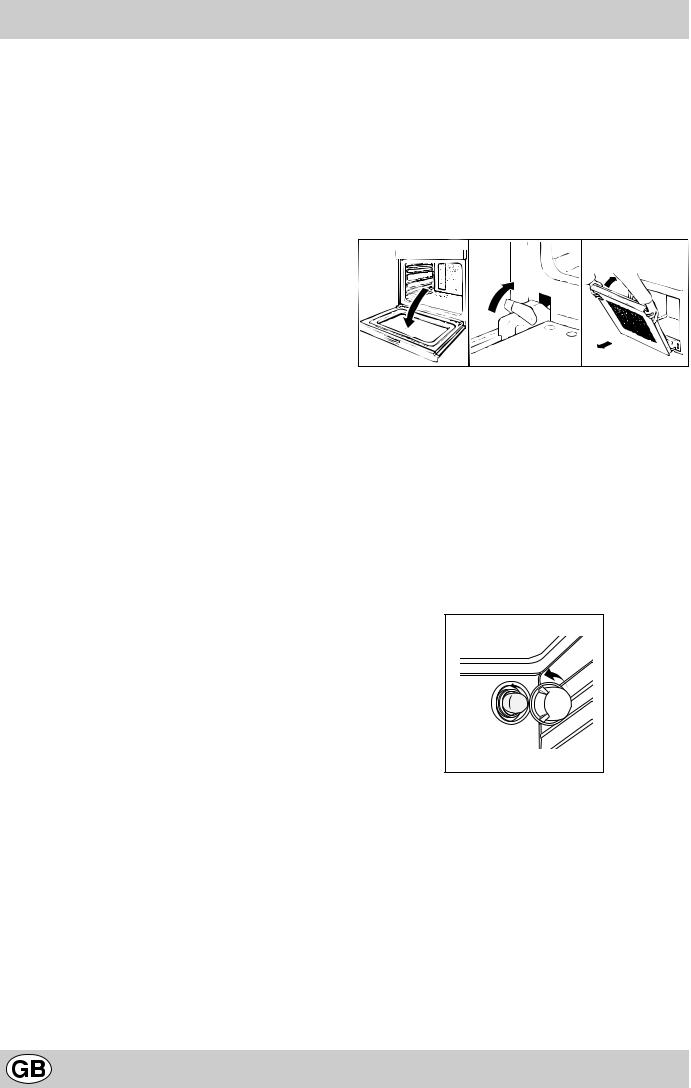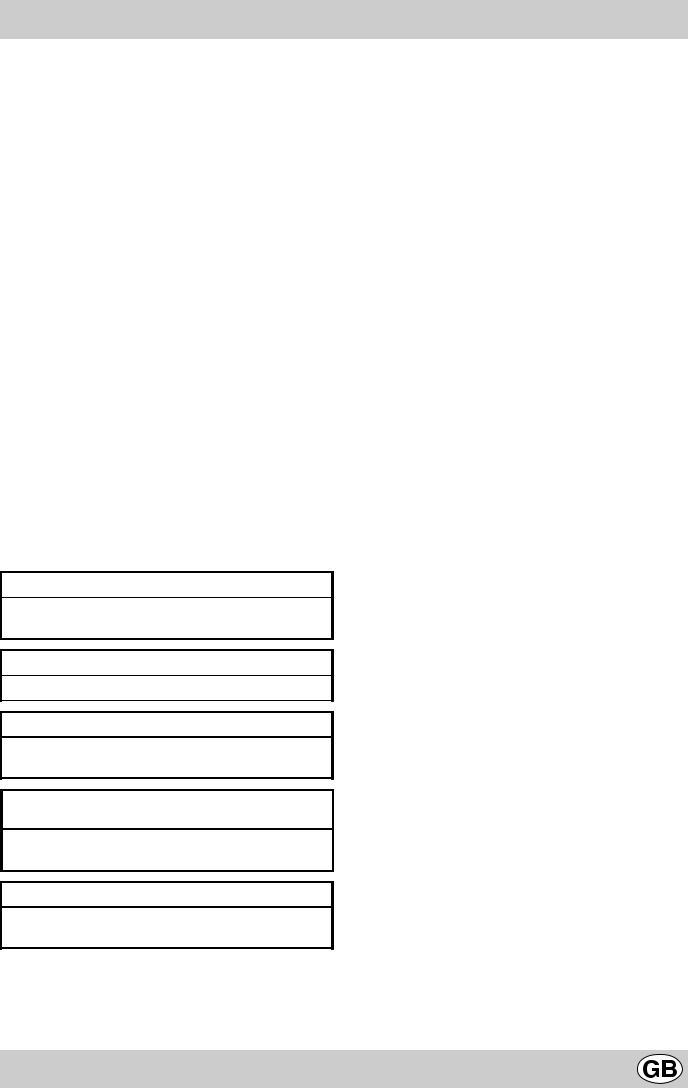Hotpoint CISHB 10 A.1 IX Manual

Congratulations on choosing an Ariston appliance, which you will find is dependable and easy to use. We recommend that you read the instructions in this owner’s manual carefully before use for the best performance and to extend the life of your appliance, as it will provide you with all the instructions you require to ensure its safe installation, use and maintenance. Always keep this owner’s manual close to hand since you may need to refer to it in the future. Thank you.
Close-up view
A.Control Panel
B.Dripping Pan or Baking Sheet
C.Oven Rack
D.Electric hotplate
E.Cooking mode selection knob
F.Electric hotplate knobs
G.Electric hotplate indicator light
H.Guides for sliding the racks or dripping pan in and out
I.Oven indicator light (only on certain models) - When lit, it indicates the oven is heating up to the temperature set.
|
|
|
|
|
|
|
G |
I |
|
|
0 |
|
0 |
|
|
0 |
|
0 |
|
0 |
|
1 |
6 |
1 |
6 |
1 |
6 |
1 |
6 |
|
|
|
|
|
|
|
|
|
|
|
MAX |
60 |
|
2 |
5 |
2 |
5 |
2 |
5 |
2 |
5 |
220 |
|
|
|
|
|
|
|
|
|
|
180 |
100 |
|
3 |
4 |
3 |
4 |
3 |
4 |
3 |
4 |
140 |
||
|
||||||||||
|
|
|
F |
|
|
|
|
E |
||
D 
 D
D
A 
 H
H
C 
 B
B
How to use your oven
The various features of this oven are controlled via the knobs and buttons located on the control panel.
Notice: The first time you use your appliance, we recommend that you set the thermostat to the highest setting and leave the oven on for about half an hour with nothing in it, with the oven door shut. Then, open the oven door and let the room air. The odour that is often detected during this initial use is due to the evaporation of substances used to protect the oven during storage and until it is installed.
Notice: Place the dripping pan provided on the bottom shelf of the oven to prevent any sauce and/or grease from dripping onto the bottom of the oven only when grilling food or when using the rotisserie (only available on certain models). For all other types of cooking, never use the bottom shelf and never place anything on the bottom of the oven when it is in operation because this could damage the enamel. Always place your cookware (dishes, aluminium foil, etc. etc.) on the grid provided with the appliance inserted especially along the oven guides.
The oven knob (E)
This knob is used not only to select the different oven modes, but also to choose the right cooking temperature from among the temperatures shown on the knob itself (from 60°C to 240°C) for the food to be cooked in the
oven. When the knob is turned clockwise, the oven light and the top and bottom heating elements will come on 8 you can choose the most suitable temperature for cooking your food from the range of values below (Convection Mode).To select the temperature, match the desired temperature with the fixed reference mark on the control panel.
60 |
• |
100 • |
140 • |
180 • |
220 Max |
|
|
|
|
|
|
|
80 |
120 |
160 |
200 |
240 |
The oven will automatically reach the temperature set, and the thermostat, which is controlled by the knob, will keep it constant.
Top Heating Element Position c
Set the knob to this position and the oven light and top heating element come on.
The oven light
Set knob “E” to the 8 symbol to turn it on. It lights the oven and stays on when any of the electrical heating elements in the oven come on.
The control knobs for the hob electric hotplates (F)
The cookers can be equipped with standard, rapid and automatic electric hotplates in a variety of combinations (the rapid hotplates can be distinguished from the rest by
2

the red boss in the centre of the same, and the automatic hotplates by the smaller circular aluminium plate in their centre).
To avoid any heat loss and damage to the hotplates, we advise you to use pans with a flat bottom, whose diameter is no less than that of the hotplate itself.
The table contains the different settings indicated on the knobs and the use for which the hotplates are recommended.
Using the hob
To get the best from your hob, here are a few helpful tips to keep in mind during cooking or when preparing food.
·Use flat-bottomed pans to ensure the same adhere fully to the cooking zone.
Setting |
Normal or Fast Plate |
|
|
|
|
0 |
Off |
|
|
|
|
1 |
Cooking vegetables, fish |
|
|
|
|
2 |
Cooking potatoes (using steam) soups, |
|
chickpeas, beans. |
||
|
||
|
|
|
3 |
Continuing the cooking of large quantities |
|
of food, minestrone |
||
|
||
|
|
|
4 |
For roasting (average) |
|
|
|
|
5 |
For roasting (above average) |
|
|
|
|
6 |
For browning and reaching a boil in a |
|
short time. |
||
|
||
|
|
Before using the hot plates for the first time, you should heat them at maximum temperature for approximately 4 minutes, without any pans. During this initial stage, their protective coating hardens and reaches its maximum resistance.
Electric hotplate indicator light (G)
This light comes on when any of the electrical hotplates on the hob have been turned on.
·Use pans whose diameter is sufficient to cover the hotplate fully, so as to guarantee the use of all the available heat.
·Make sure the bottom of the pan is always clean and dry, to ensure correct contact and a long life for your hotplates and pans.
3

How to Keep Your Oven in Shape
Before cleaning your oven, or performing maintenance, disconnect it from the power supply.
To extend the life of your oven, it must be cleaned frequently, keeping in mind that:
•Do not use steam equipment to clean the appliance.
•the enamelled or stainless steel parts should be washed with lukewarm water without using any abrasive powders or corrosive substances which could ruin them; Stainless steel could get stained. If these stains are difficult to remove, use special products available on the market. After cleaning, it is advisable to rinse thoroughly and dry.
•the inside of the oven should preferably be cleaned immediately after use, when it is still warm, with hot water and soap; the soap should be rinsed away and the interior dried thoroughly. Avoid using abrasive detergents (for example cleaning powders, etc…) and abrasive sponges for dishes or acids (such as limescale-remover, etc…) as these could damage the enamel. If the grease spots and dirt are particularly tough to remove, use a special product for oven cleaning, following the instructions provided on the packet.
•if you use your oven for an extended period of time, condensation may form. Dry it using a soft cloth.
•there is a rubber seal surrounding the oven opening which guarantees its perfect functioning. Check the condition of this seal on a regular basis. If necessary, clean it and avoid using abrasive products or objects to do so. Should it become damaged, please contact your nearest After-sales Service Centre. We recommend you avoid using the oven until it has been repaired.
•never line the oven bottom with aluminium foil, as the consequent accumulation of heat could compromise the cooking and even damage the enamel.
•clean the glass door using non-abrasive products or sponges and dry it with a soft cloth.
How to remove the oven door
For a more thorough clean, you can remove the oven door. Proceed as follows:
•open the door fully;
•lift up and turn the small levers situated on the two hinges;
•grip the door on the two external sides, shut it slowly but not completely;
•pull the door towards you, pulling it out of its seat; Reassemble the door by following the above procedures backwards.
1 |
2 |
3 |
Replacing the Oven Lamp
•Disconnect the oven from the power supply by means of the omnipolar switch used to connect the appliance to the electrical mains; or unplug the appliance if the plug is accessible;
•Remove the glass cover of the lamp-holder;
•Remove the lamp and replace with a lamp resistant to high temperatures (300°C) with the following characteristics:
-Voltage: 230/240 V
-Wattage 25W
-Type E14
•Replace the glass cover and reconnect the oven to the mains power supply.
4

Practical Cooking Advice
When cooking in the oven, use only one dripping pan or rack at a time. Select from among the top or bottom rack heights based on whether the dish needs more or less heat from the top.
Preheating
If the oven must be preheated (this is generally the case when cooking leavened foods), we recommend you use the “convection mode” to reach the desired temperature as quickly as possible. When preheating is over, which is indicated by the red light “I” going out, select the required cooking mode.
Cooking Fish and Meat
When cooking white meat, fowl and fish, use temperature settings from 180 °C to 200 °C.
For red meat that should be well done on the outside while tender and juicy in the inside, it is a good idea to start with a high temperature setting (200°C-220°C) for a short time, then turn the oven down afterwards.
In general, the larger the roast, the lower the temperature setting. Place the meat on the centre of the grid and place the dripping pan beneath it to catch the fat.
Make sure that the grid is inserted so that it is in the centre of the oven. If you would like to increase the amount of heat from below, use the low rack heights. For savoury roasts (especially duck and wild game), dress the meat with lard or bacon on the top.
Baking Cakes
When baking cakes, always preheat the oven and do not open the oven door during baking to prevent the cake from dropping. In general:
Pastry is too dry
Increase the temperature by 10°C and reduce the cooking time.
Pastry dropped
Use less liquid or lower the temperature by 10°C.
Pastry is too dark on top
Place it on a lower rack, lower the temperature, and increase the cooking time.
Cooked well on the inside but sticky on the outside
Use less liquid, lower the temperature, and increase the cooking time.
The pastry sticks to the pan
Grease the pan well and sprinkle it with a dusting of flour or use greaseproof paper.
Using the Grill
Use the d “grill” mode, placing the food under the centre of the grill (situated on the 3rd or 4th rack form the bottom) because only the central part of the top heating element is turned on.
Use the bottom rack (1st from the bottom), placing the dripping pan provided to collect any sauce and/or grease and prevent the same from dripping onto the oven bottom.
When using this mode, we recommend you set the thermostat to the highest setting. However, this does not mean you cannot use lower temperatures, simply by adjusting the thermostat knob to the desired temperature.
Important: always use the grill with the oven door shut.
This will allow you both to obtain excellent results and to save on energy (approximately 10%).
Therefore the best results when using the grill modes are obtained by placing the grid on the lower racks (see cooking table) then, to prevent fat and grease from dripping onto the bottom of the oven and smoke from forming, place a dripping-pan on the 1st oven rack from the bottom.
5

|
|
|
|
|
|
|
|
|
|
|
|
Foods |
Wt. |
Cooking position |
Temperature |
Pre-eating time |
Cooking time |
|
(Kg) |
from bottom |
(°C) |
(minuts) |
(minuts) |
|
|
|
|
|
|
Paste |
|
|
|
|
|
Lasagne |
2.5 |
3 |
210 |
- |
75-80 |
Cannelloni |
2.5 |
3 |
210 |
- |
75-80 |
Oven-baked noodles |
2.5 |
3 |
210 |
- |
75-80 |
Meat |
|
|
|
|
|
Veal |
1.7 |
3 |
220 |
- |
85-90 |
Chicken |
1.5 |
3 |
220 |
- |
110-115 |
Turkey |
3.0 |
3 |
220-Max |
- |
95-100 |
Duck |
1.8 |
3 |
220 |
- |
120-125 |
Rabbit |
2.0 |
3 |
220 |
- |
105-110 |
Pork |
2.1 |
3 |
220 |
- |
100-110 |
Lamb |
1.8 |
3 |
220 |
- |
90-95 |
|
|
|
|
|
|
Fish |
|
|
|
|
|
Mackerel |
1.1 |
3 |
210-230 |
- |
55-60 |
Dentex |
1.5 |
3 |
210-230 |
- |
60-65 |
Trout baked in paper |
1.0 |
3 |
210-230 |
- |
40-45 |
Pizze |
|
|
|
|
|
Napolitan pizza |
1.0 |
3 |
Max |
15 |
30-35 |
Tarts |
|
|
|
|
|
Biscuits |
0.5 |
3 |
180 |
15 |
30-35 |
Meringues |
1.1 |
3 |
180 |
15 |
30-35 |
Chocolate cake |
1.0 |
3 |
200 |
15 |
45-50 |
Yeast cakes |
1.0 |
3 |
200 |
15 |
50-55 |
|
|
|
|
|
|
Note: cooking times are approximate and may vary according to personal taste.
6

Safety Is A Good Habit To Get Into
To maintain the efficiency and safety of this appliance, we recommend that you do the following:
•only call the Service Centres authorised by the manufacturer
•always use original spare parts
•When handling the appliance, we recommend you always use the purpose provided handles recessed into the sides of the oven to prevent harming people or damaging the appliance itself.
•This appliance is designed for non-professional, household use and its functions must not be changed.
•These instructions are only valid for the countries whose symbols appear on the manual and the serial number plate.
•The electrical system of this appliance can only be used safely when it is correctly connected to an efficient earthing system in compliance with current safety standards.
•When the appliance is in use, the heating elements and some parts of the oven door become extremely hot. Make sure you don’t touch them and keep children well away.
The following items are potentially dangerous, and therefore appropriate measures must be taken to prevent children and the disabled from coming into contact with them:
-Controls and the appliance in general;
-Packaging (bags, polystyrene, nails, etc.);
-The appliance itself, immediately after use of the oven or grill due to the heat generated;
-The appliance itself, when no longer in use (potentially dangerous parts must be made safe).
Avoid the following:
-Touching the appliance with wet parts of the body;
-Using the appliance when barefoot;
-Pulling on the appliance or the supply cable to unplug it from the electrical outlet;
-Improper or dangerous operations;
-Obstructing the ventilation or heat dissipation slots;
-Allowing power supply cables of small appliances to come into contact with the hot parts of the appliance;
-Exposing the appliance to atmospheric agents such as rain, or sunlight;
-Using the oven for storage purposes;
-Using flammable liquids near the appliance;
-Using adapters, multiple sockets and/or extension leads;
-Attempting to install or repair the appliance without the assistance of qualified personnel.
Qualified personnel must be contacted in the following cases:
-Installation (following the manufacturer’s instructions);
-When in doubt about operating the appliance;
-Replacing the electrical socket when it is not compatible with the appliance plug.
Service Centres authorised by the manufacturer must be contacted in the following cases:
-If in doubt about the soundness of the appliance after removing it from its packaging;
-If the power supply cable has been damaged or needs to be replaced;
-If the appliance breaks down or functions poorly; ask for original spare parts.
It is a good idea to do the following:
-Only use the appliance to cook food and nothing else;
-Check the soundness of the appliance after it has been unpacked;
-Disconnect the appliance from the electrical mains if it is not functioning properly and before cleaning or performing maintenance;
-When left unused, unplug the appliance form the electricity mains and turn off the gas tap (if foreseen);
-Use oven gloves to place cookware in the oven or when removing it;
-Always grip the oven door handle in the centre as the extremities of the same may be hot due to any hot air leaks;
-Make sure the knobs are in the “•”/”o” position when the appliance is not in use.
-Cut the power supply cable after disconnecting it from the mains when you decide not to use the appliance any longer.
•The manufacturer may not be held responsible for any damage due to: incorrect installation, improper, incorrect and irrational use.
7
